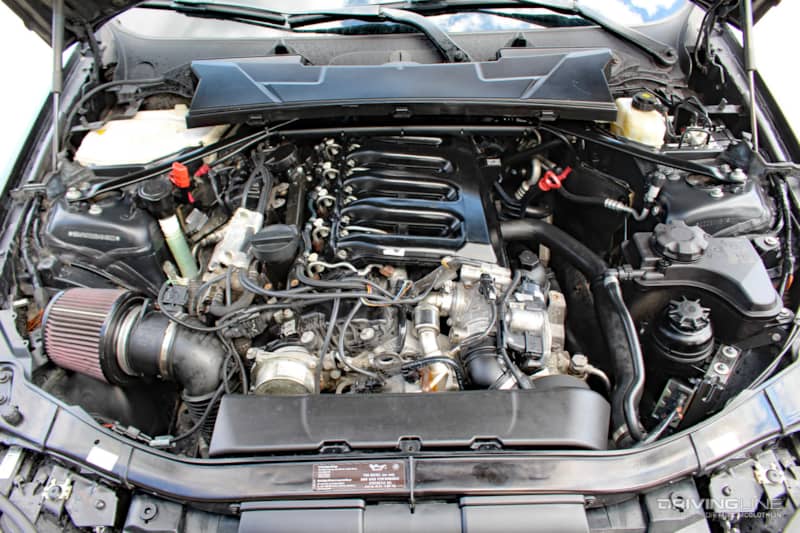Hidden In Plain Sight: The Performance Anvil That Is BMW’s M57 Diesel Engine
If you were ever trying to convert an automotive traditionalist into a diesel lover, the M57-powered BMW 335d would be the car to do it with. Not only is the Bavarian-born compression-ignition power plant clean-burning, quiet as can be and capable of achieving 35-plus mpg on the open road, but it’s expansive torque curve makes it a pleasure to drive. On top of that, the M57 diesel’s hard parts make it tough as nails—with its factory rotating assembly rumored capable of holding up to 700rwhp. But wait, there’s more… The ZF 6HP automatic transmission it comes with is equally bulletproof, not to mention a smooth operator.

Despite the current American used car market being engulfed in flames, 335d’s can still be found for reasonable prices. Provided you’re willing to put in the legwork of locating one and possibly even traveling a thousand miles to pick it up, a budget of $7,500 to $12,000 still goes a long way in this market. For that, you get a 3.0L inline-six that is an anvil of an engine, high-pressure common-rail injection, sequential turbos (yes, there are two on this bad boy) an underrated 425 lb-ft of torque, the aforementioned ZF 6HP six-speed and a low-14-second fuel-sipper. We’ll expand on all of the above down below.
An Often-Overlooked Gem

In a world chock-full of 3-series sedans, for reasons unknown the 335d continues to fly under the radar. However, those that know about them are huge fans. Only offered in the U.S. from ’09-’11, it was BMW’s way of injecting superb fuel economy into its sporty sedans. “D” owners regularly see 35-mpg or more on the highway and nearly 40-mpg can be seen under the right circumstances. In the cabin, things are as comfortable as you’d expect, but despite the diesel clattering away on the other side of the firewall things are also ultra-quiet.
What They’re Worth

Contrary to what you might think and despite the second-hand car market being on fire at the present time, the BMW 335d hasn’t experienced significant price hikes. Granted, you’ll pay more for a used ’09-’11 model now that you would’ve a year ago, but private sellers and dealerships alike don’t seem to be asking an arm and leg for them. Higher mile models are selling anywhere from $7,500 to $11,000 (110,000 miles or more) while moderate mile cars are bringing 12,000 to $17,000 (60,000 to 110,000 miles). Low-mile versions are money, however, with asking prices for those with 50,000 miles or less checking in at more than $20,000.
The Underrated, Stout I-6

The little common-rail that could, BMW’s I-6 M57 features a 3.31-inch bore, a 3.54-inch stroke, but despite displacing just 182 cubic inches, produces 265 hp at 4,200 rpm and 425 lb-ft of torque at 1,750 rpm—figures that are roughly 30 hp and 60 lb-ft underrated. The aluminum block and head M57’s robust mechanical makeup includes a forged-steel crankshaft, forged-steel rods, cast-aluminum pistons with steel ring lands and overhead cams that are chain-driven as opposed to belt-driven.
Sequential Turbos

Optimal performance at any engine speed comes courtesy of a unique, two-turbo system packaged on the passenger side of the engine. In BMW’s sequential arrangement, the high-pressure (smaller turbo) does 99-percent of the work at low engine speed, but the low-pressure (bigger turbo) takes over at higher rpm (albeit while keeping the high-pressure unit spinning at peak speed) when a valve bypassing the high-pressure charger opens. The low-pressure (or atmosphere) turbo is a BorgWarner K26 and the high-pressure unit is a BorgWarner K39. The K26 is wastegated to bleed off excess drive pressure, which prevents overspeeding.
High-Pressure, Precise Fuel Delivery = Big Potential

Much of the M57’s ability to turn out horsepower and torque numbers that rival diesel engines twice its size lies in its high-pressure common-rail injection system. Quick-firing piezo electric injectors from Bosch provide precise in-cylinder fuel delivery and a Bosch CP3 high-pressure fuel pump pressurizes diesel as high as 23,200 psi. Thanks to the potency of these fuel system components, a well-crafted file uploaded to the ECM that taps into this potential can result in a car that’s capable of breaking into the 12’s in the quarter-mile.
Emission-Fighting Hardware (ALL Of It)

There’s plenty of alphabet soup to go around as far as the M57’s emissions control devices are concerned. This includes a DOC (diesel oxidation catalyst), DPF (diesel particulate filter), SCR (selective catalytic reduction, which requires DEF, or diesel exhaust fluid) and this little guy, the EGR cooler that’s part of the engine’s exhaust gas recirculation system. While the EGR cooler—which mounts at the front of the M57 and is surprisingly easy to access—has its fair share of problems as miles rack up, it isn’t nearly as problematic as certain components in the SCR system can be. In particular, the DEF system’s sensors and heater tend to die very premature deaths.
The Chink In The Armor

One of few notable points of worry for the M57 exists in its composite intake manifold. The swirl flaps on the intake ports, which are designed to maximize airflow into the head and improve fuel economy, are made of plastic. Over time, and after many miles of being exposed to the exhaust gases and blowby the intake sees, they begin to break down and can eventually disintegrate and be sent into the head. Performance-minded drivers and owners after utmost reliability usually remove the swirl flaps from the intake manifold to keep this kind of failure from ever surfacing.
Tire-Shredding Torque

Not that it’s ever a good idea to melt down a pair of tires, but the M57 engine’s abundance of low-end torque makes it exceptionally easy. The owner of this 335d bid the rear mounted Nitto Motivo tires farewell when it was his turn on the burnout pad. The little BMW didn’t disappoint and in fact surprised onlookers who were unaware BMW once offered a stateside 3-series oil-burner.
More From Driving Line
- If BMW’s M57 diesel rings a bell, it should. We included it in our 4-part Unkillable Diesels series that kicked off in 2020. That article is available right here.











